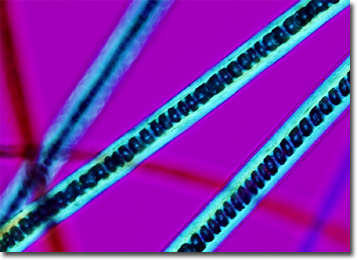Polarized Light Microscopy Digital Image Gallery
Mink Hair
Usually made into opulent coats and outer apparel, minks, which are highly valued for their thick, lustrous fur, have been the primary focus of many animal rights activists. Nevertheless, the pelt of the mink continues to comprise the greater part of pelts generated each year by fur farms around the world.

Minks are semi-aquatic weasels that belong to the genus Mustela. One of the two species belonging to the genus is native to North America, while the other inhabits Central Asia and Europe. Both species have long, slender necks and bodies, short limbs, and bushy tails, but the Old World minks are generally slightly smaller than the North American variety. The nocturnal animals are exceptional swimmers and spend much of their time nearby bodies of water. They are also excellent hunters depending primarily upon their sense of smell to capture a wide variety of prey, including fish, crustaceans, frogs, birds, and muskrats.
In the wild, minks typically exhibit fur that is dark brown in color with white patching on the underside of the body. However, raised on ranches since the 1860s, domestic minks have been bred to create a wide variety of color morphs. Mink farmers have also selectively bred the animals to produce the highest quality of furs possible, reducing the percentage of coarse guard hairs the pelts contain and creating an even denser soft underfur. The treatment of minks on ranches, however, has been the subject of significant controversy. Territorial by nature, minks kept cages in close quarters can undergo a significant amount of stress. Moreover, many object to the practice of mink farming simply because they consider using the fur of the animals unnecessary since there are so many other fibers available that do not necessitate the killing of animals.
